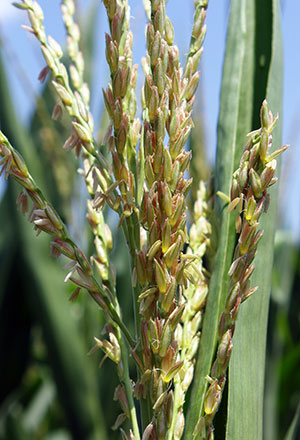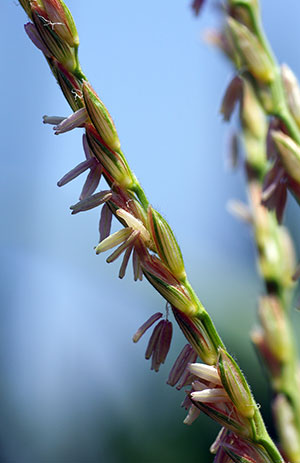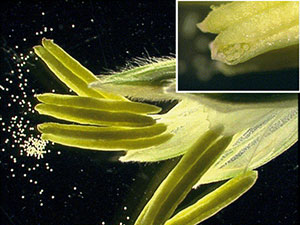Taking an environmentally sensitive approach to pest management
Corn Pollination, the Good, the Bad, and the Ugly
Part 1: The Male RolePublished: July 11, 2012
Corn is unique among grain crops in that it is monoecious. This means that it possesses flowers that have only male sexual parts and flowers that have only female sexual parts on the same plant. Also unique among grain crops, these flower types are separated on a plant by a distance of several feet. To compensate for this physical separation of male and female flower parts, the corn plant produces copious amounts of pollen and its pollen is easily moved by wind.

Figure 1. Fully emerged corn tassel. Tassel branches have not displayed normally, perhaps because of hot and dry weather.
Male flowers are borne on the tassel. When the corn plant is only 4 or 5 weeks old and about knee-high, the growing point changes from a place for cell division into a reproductive structure – the embryonic tassel. At this point in the growing season, the tassel is at or near the soil surface. The young tassel is pushed through the whorl of leaf sheaths as nearly 20 stem internodes elongate. During these five weeks of stem elongation, the tassel becomes increasingly “tassel-like” in appearance. Inside the anthers of the developing tassel special cells produce pollen grains. These pollen grains mature and are ready to perform their role of producing male gamete cells as plant development approaches the end of this period of rapid stem elongation. The last stem internode, or the peduncle, elongates and pushes the tassel out of top leaf sheath (Figure 1). VT is the last vegetative stage and occurs when the last (bottom) tassel branch is visible.

Figure 2. Tassel branch with several anthers visible.
Normal tassels have a central stalk (rachis) and several branches. Grass flowers are called florets, and each of the nearly 2000 florets on the tassel produces three stamens composed of an anther and a filament. The filament elongates and pushes the anther out of the floret, which exposes the anther to the air (Figure 2). Weather parameters, including temperature, humidity, and wind speed influence the timing and the amount of pollen shed. Under normal conditions, temperature rises and relative humidity decreases as the morning progresses. This triggers the anthers to dehisce, which allows pollen grains to spill from pores located near one end of each anther (Figure 3). A slight breeze may be necessary for pollen shed, or at least it helps with pollen dispersal.
Pollen shed begins shortly after the tassel emerges from the top leaf sheath and lasts about 8 days for an individual tassel. Because of differences among plants in a field for maturity, pollen shed within a field may last two weeks. This “flowering period” for corn is relatively short, and corn yield can be highly influenced by stresses that occur during it.
Although the science is a little foggy, it appears that both heat and drought can damage pollen. Some reports state that temperatures above 95ºF kill corn pollen. It is not clear to me if pollen death is a reaction solely to temperature or from dehydration. This year central Missouri experienced 12 consecutive days with high temperatures above 100ºF during pollen shed. This is highly unusual and outside the parameters of most research protocols. It is clear that pollen grains are highly susceptible to dehydration. Pollen grains are small, have a large surface area to volume ratio, and thin walls. They begin to lose water immediately after their release from anthers. Even with normal summer temperatures and humidity, pollen grains will lose most of their water in less than 4 hours. Under conditions common in most of Missouri’s cornfields this year, nearly complete dehydration will take less than an hour.

Figure 3. Figure 3. Anthers with closeup of opening from which pollen grains exits athers. Source of picture: Aylor et al. 2003.
Tassels are relatively large inflorescences and produce many flowers. Estimates of pollen grain production range from 2 to 25 million pollen grains per tassel. Under normal summer conditions, most tassels in Missouri corn fields should produce at least 5 million pollen grains. Since a common ear size is nearly 1000 female flowers there are at least 2000 pollen grains for every silk and maybe as high as 25,000. Some corn seed companies use male sterility in producing their hybrids. So for some hybrids, not every tassel in a field will be fertile. Because so many pollen grains are produced by male fertile tassel under all but extreme weather conditions, there is usually plenty of pollen for all receptive silks in a field.
In Part 2 of this series I’ll discuss the role of the female flowers, and in Part 3 I’ll discuss factors that influence the fertilization process.
Sources
Aylor, DE, NP Scultes, and EJ Shields. 2003. An aerobiological framework for assessing cross-pollination in maize. Agricultural and Forrest Meteorology 119:111-129.
Nielsen, RL (Bob). 2010b. Tassel Emergence & Pollen Shed. Corny News Network, Purdue Univ. [On-Line]. Available at http://www.kingcorn.org/news/timeless/Tassels.html.
Subscribe to receive similar articles sent directly to your inbox!
- Weather and Soybean Yields (11/03/15)
- 2013 is Another Drought Year (09/10/13)
- Increased Arrested Development of Corn Kernels May Have Resulted from Cloudy Weather (09/05/13)
REVISED: October 1, 2015